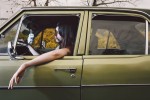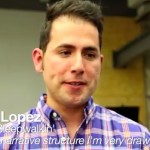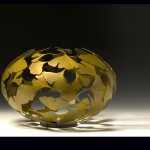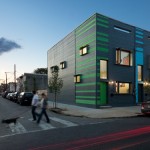As visitors enter Nik Pence and Alyse Ronayne’s installation “Liminal Refraction” at Extra Extra Gallery, they may feel as though they have stepped through Alice’s looking glass. A large wooden frame constructed by Pence divides the gallery space into two halves. This frame at first seems to signify a mirror. Two suitcases have been positioned on either side of the structure at similar angles—as have two rocks, two hammers, and two overturned plants. At closer range, however, it becomes clear that the objects on either side of the frame are not quite identical.
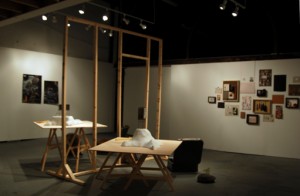
This is no accident. Pence and Ronayne emphasize that the underlying theme of their show is “refraction” rather than “reflection.” Much of their work involves re-creating everyday objects as though seen through a distorting prism. The hammers in Pence’s mirror structure are made of orange plastic rather than metal. Ronayne’s largest piece in the show, Cakewalk, is a glittering circle of bundt cake sculptures. The appeal of these “desserts” is deceptive, as they are in fact molded from toxic foam and decorated with debris from Ronayne’s studio. By nullifying the intended use of tools and foods, Pence and Ronayne inspire the viewer to see these objects’ aesthetic value rather than their functionality. Visitors should take time to explore the off-kilter wonderland at Extra Extra completely; while Pence’s impressive contribution is most visible, many of Ronayne’s photographs and exquisitely crafted miniatures are tucked into the nooks of the gallery.
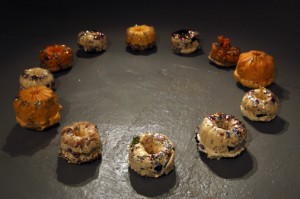
Despite its name, the Great and Terrible Collective is a welcoming and intimate space, operated by six recent graduates of Moore College of Art in a recently converted row house. This month’s inaugural show, “Mystery Flavor,” includes a work of art from each founding member. The pieces are of varied levels of execution and originality, but two standouts are films by Bailey Goldenbaum and Breana Copeland. To make Michael Jackson Isn’t Alive, Goldenbaum converted footage from an early Jackson music video to slow motion and low resolution. The conceit is simple, but the end result is eerily prescient of Jackson’s eventual fate; in Goldenbaum’s version, Jackson’s expressions appear pensive and moody, and his highly pixilated features are distorted as if by plastic surgery. Breana Copeland’s Food Stories is a funny yet moving commentary on food’s relevance to every stage of life. In voiceover, we hear Copeland conducting short conversations with different women about the memories they associate with particular foods. Pizza makes one woman think of her elementary school attendance record, salad reminds another of her attempts to lose weight, and chili reminds a third woman of her pregnancy cravings. The accompanying stop-motion visual shows the foods transforming into schoolgirls, numbers, scales, and other stylized motifs from the stories.
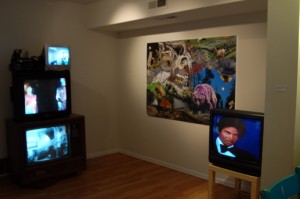
Another inaugural show is ongoing this month at Artspace Liberti, operated by Liberti Church East. On First Friday, the lofty multi-purpose space was packed with visitors who munched on hors d’oeuvres to the accompaniment of a live band. “Inside Outside,” the two-person exhibition of photographs by Mark Havens and Seth Shimkonis, well deserved this fanfare.
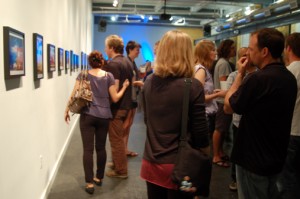
The focus of both Havens and Shimkonis’ work is on landscape and architecture. Shimkonis’ photographs, which are sharply rendered and saturated in color, explore the artist’s own neighborhood in Fishtown. Some of them, such as an image of sneakers looped over telephone wires against a cloudy blue sky, contrast the concept of personal or gang turf with the ideal of freedom. Others, including a depiction of two doors of different sizes and colors side-by-side, suggest a more tolerant coexistence.

Mark Havens explained to me that his softly lit work is inspired by the desire to capture “the residual, gossamer threads of emotion left after people leave a space.” This aim is particularly evident in his untitled photograph of a dining room after the end of an Easter dinner. Although the room is devoid of people, the objects remaining on the table—a porcelain pitcher, a greeting card, a doggy bag, a broken toy parachute—hint at the characters and interrelationships of those who recently inhabited it.
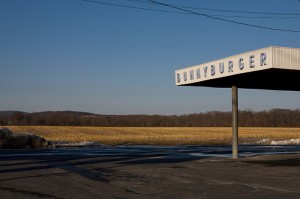
Havens cheerfully conceded that the emotions and memories his photographs evoke in the viewer may be different from the ones he originally intended to capture. He pointed to another untitled photograph, which shows the parking lot of a restaurant in front of a field of yellowing grass and a dark strip of hills in the distance. Earlier in the evening, a visitor had told Havens that the scene embodied his idea of the American Midwest. A different visitor had been reminded of his childhood memories of New Jersey. To Havens himself, the landscape is evocative of Pennsylvania–the place where it was in fact taken. But regardless of the particular “threads of emotion” Havens pulls in you, his richly layered but subtle images are sure to resonate strongly.


